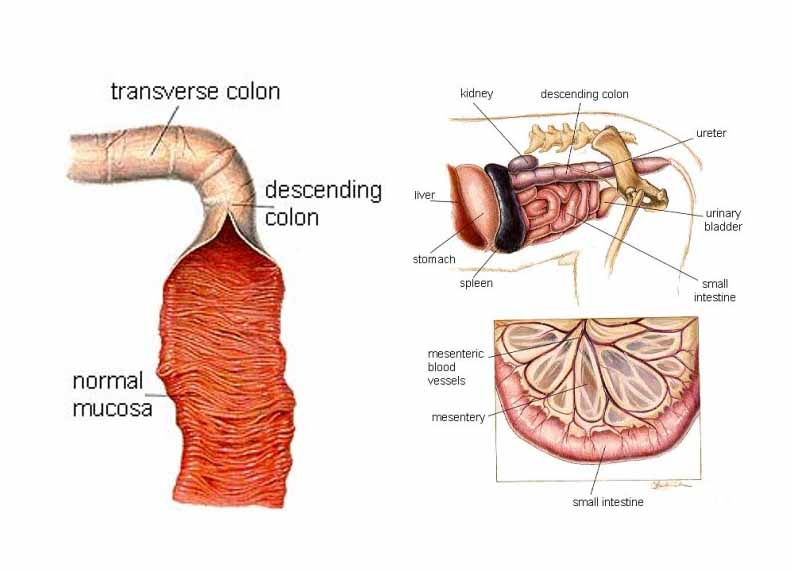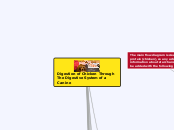
Digestion of Chicken Through The Digestive System of a Canine

1. Mouth
The first, most integral part of the process is what to insert in the chomping mouth of the dog. It is important to consider the nutritional value of the products.
Carbohydrates
Although the boiled chicken breast does not contain carbohydrates, it is still an important nutrient category to consider. Monosaccharides are the easiest to digest, with the difficulty increasing as the number of simple sugars in the molecule increases. They provide energy for the dog at the cellular level.
The pizza crust contains 24 g of carbohydrates in 1/8 of a crust. This is a great source of energy for the dog as it is a complex carbohydrate.
Water
Water trapped in the chicken breast is essential for the dog as water is needed for all biological processes and the body is made up of 57% of the total body weight in mature animals. Also, dehydration is detrimental and can be caused if the water is not tailored to mineral and activity levels of the dog.
Protein
Protein is essential for the dog to be able grow and develop properly. It is also one of the main macromolecule found in the diet of omnivores and carnivores. Essential amino acids are supplied to the body through the addition of protein to the diet. The chicken is a good source of protein for the dog, containing 29 grams in 3 ounces!
Lipids
One ounce of boiled chicken breast contains 0.8 grams of fat, or lipids. Lipids are essential for glossy and healthy coat and skin, yet must be monitored because the risk of obesity is high. They are needed for utilization of fat-soluble vitamins, insulation, and are highly digestible. Chicken is also a source of Essential Fatty Acids(Linoleic and Linolenic Acid), which cannot be synthesized by the body. It is important to remember that trans fat increases bad cholesterol and decreases good, so it should be limited or excised from the diet. This chicken contains none.
1/8 pizza crust contains 1.5 grams of fat, which is quite high because dog already get a balanced diet from their regular dog food, so the additional fat can add problems. Also important to consider, there may also be butter used to bake the crust, so that is also additional calories and fat.
One large Milkbone treat contains 5% crude fat according to the guaranteed analysis. This is important to keep in mind if weight loss or weight gain is desired for the dog. Healthier treat options are available for weight loss, such as green beans, pumpkin, and even ice cubes!
Minerals
Minerals are naturally occurring inorganic substances or solids formed through geological processes. Macrominerals are Ca, P, Mg which are bone minerals; Na, K, and Cl which are electrolyte minerals; and S which is a structural mineral. This chicken contains iron, copper, zinc, selenium, manganese, and phosphorus among others. Some trace minerals include copper, cobalt, iron, iodine, etc. It is important to supplement these in the dog's diet so the dog does not become deficient.
As for the minerals in pizza crust, a main talking point is the 240 mg of sodium (Na) in the crust. This electrolyte mineral is important for nerve impulse transmission, yet too much (hypernatremia) can lead to hypertension.
Milkbone treats contain phosphorus, copper, zinc, and iodine.
Vitamins
Vitamins are grouped by their solubility (fat vs water soluble) and differ in function and storage. In the chicken, there is Vitamins A, B12, B6, C, D, E, Niacin, Pantothenic Acid, Riboflavin and Thiamin. These all work towards keeping all aspects of the dog running smoothly, from the eyes seeing clearly (Vitamin A) to the coat being shiny (Pantothenic Acid)
Surprisingly, Milkbone treats contain many vitamins that are essential for proper growth and maintenance in canines. These vitamins include Vitamins A, D, E, B12, Riboflavin, Pantothenic Acid, and Choline.
The next important aspect is how the chicken beings the digestive process in the mouth. The teeth of the dog physically break down the fibers in the chicken. Salivary glands secrete sodium bicarbonate to buffer the environment. Mucin lubricates the food.
Salivary amylase secreted by salivary glands serve to break down starches and carbohydrades in the mouth as they are also being physically broken down by the teeth. This process makes them easier to pass through the esophagus and jump starts the digestion process.
Once the chicken is effectively broken down into a pulp, it is then ready to move onto the esophagus

2. Esophagus
The esophagus is a muscular tube that connects the mouth of the dog to the stomach. It contains longitudinal smooth muscles that facilitate swallowing (delutition) and peristalsis (muscular contractions). The chicken is now in a bolus (circular shape) and travels down into the stomach.

3. Stomach
Now the chicken has reached the first extensive area of digestion, and is stored here for about 2-4 hours. Both physical and chemical digestion occurs. The pH in the stomach can reach as low as 2 or 3, which is very acidic.
Physical Digestion: churning
Chemical Digestion: enzymes and HCl
Protease breaks down the peptide bonds in the chicken.
Peptic cells secrete pepsinogen (zymogen) to create pepsin.
Lipase is the main enzyme which breaks down fats once they reach the stomach. The lipids are hydrolyzed and are broken down to create fatty acids and glycerols.

4. Small Intestine
Layers of the small intestine:
epithelium
connective tissue
smooth muscle
external layer
3 Sections of the Small Intestine:
Duodenum
The duodenum is the active site of digestion. It contains trypsin, chymotrypsin, elastase, carboxypeptidase A and B, which all digest the protein contained in the chicken. They are all pancreatic juices as well which are pancreatic secretions from the pancreatic duct.
Two other important enzymes for digesting the protein in chicken are pancreatic lipase and amylase. These further digest the chicken.
Bile, from the gallbladder, serve to emulsify lipids from the dog treats. Also, micelles are created to transport these lipids through the aqueous small intestine to be used by the body for energy. The lipids also stimulate the CCK in the Cholesystokinin which causes the pancreas and gallbladder to contract.
Micelles involved in metabolism:
TAG
DAG
MAG
FFA
Cholesterol
The maltose and sucrose in the pizza crust are digested by maltase and sucrase, which are active enzymes made by enterocytes.
Jejunum
The jejunum digests the chicken in three different ways; simple/passive diffusion, facilitated diffusion, and active transport. This, coupled with the fact that it is the longest section, makes it the place of most nutrient absorption.
Both the pizza crust and Milkbone treats go through this process as well.
Ileum
The ileum is the site of residual nutrient absorption. This means that most of the nutrients that will be obtain from the chicken have been absorbed through the first two sections, and anything left over is absorbed through the ileum.
Both the pizza crust and Milkbone treats go through this process as well.
The chicken now proceeds to the small intestine to be further digested and the nutrients listed previously be absorbed through the walls to be used by the body. After the Ileum, the chicken will then pass into the large intestine.
Additional: Lipoprotein Transport
Chylomicrons transport long chain fatty acids through the lymphatic system, to tissues, and eventually end up in the liver to be broken down.
VLDL (very low density lipoprotein) are produced in the liver and deliver fatty acids to tissues.
IDL (intermediate density lipoprotein) have delivered some fatty acids to tissues so ratio of fatty acids to cholesterol is more even.
LDL (intermediate density lipoprotein) have delivered most of their fatty acids to tissues and are now mostly made of cholesterol. They then deliver this cholesterol to cells and between cells.
HDL(high density lipoproteins) are made in the liver and are mostly made of protein because they are empty so they can pick up cholesterol from around the circulatory system.
Fats from all three foods (chicken, pizza crust and Milkbone treat serve to provided the fatty acids to these lipoproteins.
Additional: When Fatty Acids
Reach the Cell
Lipoprotein lipase found on surfaces of cells removes fatty acids from the TAG to allow fatty acids to enter the cell.
When the cells of the dog require energy, they body makes LPL.
The fatty acids now have two destinations: they are either stored in adipose tissue for later use, or move on to the beta-oxidation cycle, which is a metabolic cycle which makes energy for the cell to use.
Additional: Beta-Oxidation
how fatty acids are used to make energy for the cell
occurs in the mitochondria
Fatty acids are chopped into 2 carbon units, and pushed through the TCA cycle and produces ATP which is energy for the cell
Additional: Lymphatic System
Functions:
-carries fluid away from tissues to filter through lymph nodes which are part of the immune system
-drains excess fluid from interstitial spaces between cells
-transports materials too large to enter capillaries ( fatty acids over 14 carbons long)
5. Cecum (Large Intestine)
This is the pouch at the junction of the small and large intestines. Although it varies in size and shape between species, the function stays constant; this is the place of microbial digestion of fibrous carbohydrates, place of the production of VFA (volatile fatty acids) by microbes, and also where microbes synthesize the numerous B-vitamins. The chicken fuels these microbes and aids in these vital nutrients being available for the dog to utilize.
The carbohydrates contained in the pizza crust are further broken down with the help of microbes.

6. Colon (Large Intestine)
In this section of the large intestine, cubiodal cells and goblet cells (which secrete mucous) have the same functions as the cecum. In addition to these functions, the colon water is reabsorbed from the chicken and the remaining material is concentrated into feces.
Both the pizza crust and Milkbone treats go through this process as well.

7. Rectum (Large Intestine)
This is the last section of the large intestine where the undigested chicken material is formed inot feces. This material is made up of unabsorbed chicken, dead bacteria, sloughed cells, and fluids that have accumulated from the process of digestion.
Both the pizza crust and Milkbone treats go through this process as well.

8. Anus
The anus is essentially the final destination for the ingested and digested chicken the dog ate. The anus controls the exit of feces and is the very last part of the alimentary tract.
Both the pizza crust and Milkbone treats go through this process as well.

Main topic
And there we have it folks! Everything must come to an end, and hopefully this end step happens somewhere outside of the house!
